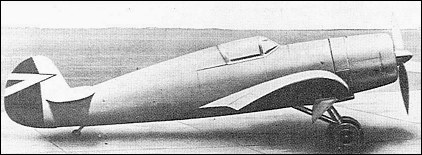|
| Following the termination of plans for the aircraft division of the Weiss Manfred concern to build the Heinkel He 112 single-seat fighter under licence, the division's chief designer, Bela Samu, initiated work on an indigenous fighter. Designated WM-23 and named Ezustnyil (Silver Arrow), the fighter's design was launched in July 1940, and owed much to the He 112. The wing section and planform of the He 112 were retained, together with the camber-changing Fowler flaps and Heinkel's use of anhedral to reduce undercarriage height, but metal gave place to wooden construction. The plywood-covered wooden wings were mated with a welded steel-tube fuselage, also primarily plywood covered, and a WM-K-14B (licence-built Gnome-Rhone 14Kfrs Mistral Major) 14-cylinder radial engine of 1000hp. The proposed armament comprised two 7.62mm Gebaur machine guns in the wings and two synchronised 20mm MG 151 cannon in the fuselage.
The prototype WM-23 was flown for the first time in September 1941, and demonstrated good flying characteristics, but suffered intermittent aileron oscillation, and, in the late spring of 1942, the starboard aileron detached in a climb, forcing the pilot to abandon the aircraft.
Plans had meanwhile reached an advanced stage for the all-metal Ezustnyil II with a monocoque fuselage and a DB 605 engine. However, this programme was eventually discontinued with the decision that Weiss Manfred would build the Messerschmitt Bf 109G under licence.
 | A three-view drawing (1658 x 1260) |
| WEIGHTS |
| Empty weight | 3290 kg | 7253 lb |
| DIMENSIONS |
| Wingspan | 10.60 m | 35 ft 9 in |
| Length | 10.80 m | 35 ft 5 in |
| Height | 3.55 m | 12 ft 8 in |
| Wing area | 23.50 m2 | 252.95 sq ft |
| PERFORMANCE |
| Max. speed | 530 km/h | 329 mph |
| lxbfYeaa, e-mail, 15.11.2025 14:17 20 reply | | Tony, e-mail, 05.07.2017 16:47 The empty weight quoted here looks shockingly high for an available 1000hp - did it really weigh 7253lbs? reply | | FodiChannelRussia, e-mail, 19.01.2017 08:28 THIS IS AWESOME PLANE! reply | | argeo, e-mail, 18.07.2012 20:26 Machinegun Armament was 7.92mm calibre machine guns.
Gebauer produced machine guns in 7.92 × 57mm (German) and 8 × 56R (Hungarian Army) reply | |
| | pree, 18.06.2011 10:29 GREAT SITE. I never knew of a Hungarian fighter, so I clicked this one first. I had the immediate feeling of a strong resemblance to the He-112. reply |
| Vincent, e-mail, 08.01.2011 02:22 As for me, I think it rather looks like a Bf109X, the 109 version powered with a radial Fw190 engine.
But I agree, wings have clearly the same design as the He112 ones. reply |
| riccardo, e-mail, 02.09.2010 11:50 GREAT SITE. I never knew of a Hungarian fighter, so I clicked this one first. I had the immediate feeling of a strong resemblance to the He-112. reply | | Zizi, e-mail, 13.07.2007 16:31 airwar.valka.cz /muzeum /ostatni /wm_23 /default.htm reply | | alejandro castillo from MEXICO, e-mail, 08.04.2007 02:08 thank for plane, never she. reply |
|
Do you have any comments?
|
| 
All the World's Rotorcraft |







 lxbfYeaa
lxbfYeaa
20
reply